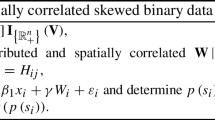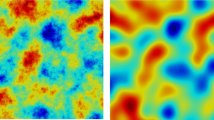Abstract
Natural processes encountered in mining, hydrogeologic, environmental, etc. applications usually are poorly known because of scarcity of data over the area of interest. Therefore, stochastic estimation techniques are the tool of choice for a careful accounting of the heterogeneity and uncertainty involved. Within such a framework, a better utilization of all available data concerning the process of interest and all other natural processes related to it, is of primary importance. Because many natural processes show complicated spatial trends, the hypothesis of spatial homogeneity cannot be invoked always, and the more general theory of intrinsic spatial random fields should be employed. Efficient use of secondary information in terms of the intrinsic model requires that suitable permissibility criteria for the generalized covariances and cross-covariances are satisfied. A set of permissibility criteria are presented for the situation of two intrinsic random fields. These criteria are more general and comprehensive than the ones currently available in the geostatistical literature. A constrained least-square technique is implemented for the inference of the generalized covariance and cross-covariance parameters, and a synthetic example is used to illustrate the methodology. The numerical results show that the use of secondary information can lead to significant reductions in the estimation errors.
Similar content being viewed by others
REFERENCES
Ahmed, S., and de Marsily, G. 1987, Comparison of geostatistical methods for estimating transmissivity using data on transmissivity and specific capacity: Water Resource Res., v. 23,no. 9, p. 1717–1737.
Cassiani, G., 1995, Criteria of permissibility for generalized cross-covariances and intrinsic cokriging: Stochastic Research Group, Research Rept. No. SM/5.95, Dept. of Environmental Sci. and Engin., Univ. North Carolina, Chapel Hill, North Carolina, 35 p.
Chiles, J. P., and Guiller, A., 1984, Variogrammes et krigeages pour la gravimetrie et le magnetisme: Sciences de la Terre, Serie Informatique, v. 20, p. 455–468.
Christakos, G., 1984, On the problem of permissible covariance and variogram models: Water Resources Res., v. 20,no. 2, p. 251–265.
Christakos, G., 1992, Random field models in earth sciences: Academic Press, San Diego, California, 474 p.
Christakos, G., 1997, An analysis of the disease/exposure association using a vector random field model: submitted to Jour. Exposure Analysis & Environmental Epidemiology.
Christakos, G., and Hristopulos, D. T., 1998, Tractatus stochasticus: the study of spatiotemporal environmental and health processes. Kluwer Academic Publishers, Dordrecht, the Netherlands, forthcoming.
Christakos, G., and Raghu, R., 1996, Dynamic stochastic estimation of physical variables: Math. Geology, v. 28,no. 3, p. 341–365.
Christakos, G., and Thesing, G. A., 1993, The intrinsic random field model and its application in the study of sulfate deposition data: Atmospheric Environment, v. 27A,no. 10, p. 1521–1540.
Cressie, N., 1991, Statistics for spatial data: John Wiley & Sons, New York, 900 p.
Delfiner, P., 1976, Linear estimation of nonstationary spatial phenomena, in Guarascio M., and others, eds., Adv. Geostatistics in the Mining Industry: D. Reidel Publ. Co., Dordrecht, The Netherlands, p. 9–68.
Delhomme, J. P., 1978, Kriging in the hydrosciences: Advances in Water Resources, v. 1,no. 5, p. 251–266.
Dimitrakopoulos, R., 1990, Conditional simulation of intrinsic random functions of order k: Math. Geology, v. 22,no. 3, p. 361–380.
Dowd, P. A., 1989, Generalized cross-covariances, in Armstrong M., ed., Geostatistics: Kluwer Acad. Publ., Amsterdam, The Netherlands, p. 151–162.
Dowd, P. A., 1992, A review of recent developments in geostatistics: Computers & Geosciences, v. 17,no. 10, p. 1481–1500.
Francois-Bongarcon, D., 1981, Les coregionalisations, le cokrigeage: Publ. n.C-86, Centre de Geostatistique, Ecole des Mines de Paris, Fontainebleau, France, 25 p.
Gelfand, I. M., and Vilenkin, N. Y., 1964, Generalized functions-4: Academic Press, New York, 384 p.
Goff, J. A., and Jordan, T. H., 1988, Stochastic modelling of seafloor morphology-Inversion of sea beam data for second-order statistics: Jour. Geophys. Res., v. 93,no. B11, p. 13,589–13,608.
Goulard, M., and Voltz, M. 1992, Linear coregionalization model: tools for estimation and choice of cross-variogram matrix: Math. Geology, v. 24,no. 3, p. 269–286.
Haas, T. C. 1990, Kriging and automated variogram modelling within a moving window: Atmospheric Environment, v. 24A,no. 7, p. 1759–1769.
Haining, R., 1990, Spatial data analysis in the social and environmental sciences: Cambridge Univ. Press, Cambridge, 409 p.
Journel, A. G., and Huijbregts, Ch., 1978, Mining geostatistics: Academic Press, New York, 600 p.
Kitanidis, P. K., 1983, Statistical estimation of polynomial generalized covariance functions and hydrologic applications: Water Resources Res., 19,no. 4, p. 909–921.
Kunsch, H. R., Papritz, A., and Bassi, F., 1996, Generalized cross-covariances and their estimation. Res. Rept. no. 77, Seminar fur Statistik, Eidgenossische Technische Hochschule, Zurich, Switzerland, 18 p.
Matheron, G., 1971, The theory of regionalized variables and its applications: Fascicule 5, Les Cahiers du Centre de Morphologie Mathematique, Ecole des Mines de Paris, Fontainebleau, France, 211 p.
Matheron G., 1973, The intrinsic random functions and their applications: Adv. Appl. Prob., v. 5,no. 3, p. 439–468.
Myers, D. E., 1982, Matrix formulation of co-kriging: Math. Geology, v. 14,no. 3, 249–257.
Neuman, S. P., 1982, Statistical characterization of aquifer heterogeneities-an overview, in Recent Trends in Hydrogeology: Geol. Soc. America, Spec. Paper, v. 189, p. 81–102.
Olea, R., 1972, Application of regionalized variable theory to automatic contouring: Kansas Geol. Survey, Lawrence, Kansas, 191 p.
SANLIB, 1995, Stochastic analysis software library and user's guide: Stochastic Research Group, Research Rept. No. SM/1.95, Dept. of Environmental Sci. and Engin., Univ. North Carolina, Chapel Hill, North Carolina.
Starks, T. H., and Fang, J. H., 1982, On the estimation of the generalized covariance function: Math. Geology, v. 14,no. 1, p. 57–64.
Stein, A., van Eijnsbergen, A. C., and Barendregt, L. G., 1991, Cokriging nonstationary data: Math. Geology, v. 23,no. 5, p. 703–719.
Wackernagel, H., 1995, Multivariate geostatistics: Springer, New York, 250 p.
Webster, R., 1985, Quantitative spatial analysis of soil in the field: Advances in Soil Science, v. 3, p. 1–70.
Yaglom, A. M., 1986, Correlation theory of stationary and related random functions: basic results: Springer-Verlag, New York, 526 p.
Yaglom, A. M., and Pinsker, M. S., 1953, Random processes with stationary increments of order n: Dokl. Acad. Nauk USSR, v. 90, p. 731–734.
Zimmerman, D. A., and Wilson, J. L., 1990, Description of and user's manual for TUBA: a computer code for generating two-dimensional random fields via the turning band method: SEASOFT, Albuquerque, New Mexico, 116 p.
Author information
Authors and Affiliations
Rights and permissions
About this article
Cite this article
Cassiani, G., Christakos, G. Analysis and Estimation of Natural Processes with Nonhomogeneous Spatial Variation Using Secondary Information. Mathematical Geology 30, 57–76 (1998). https://doi.org/10.1023/A:1021761305044
Issue Date:
DOI: https://doi.org/10.1023/A:1021761305044




